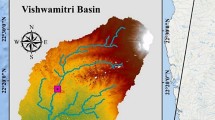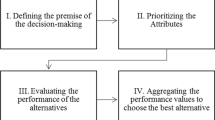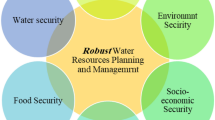Abstract
In theory, emergence of robustness concept has pushed decision-makers toward designing alternatives, such as resistant against the potential fluctuations fueled by uncertain surrounding environment. This study promotes an objective-based multi-attributes decision-making framework that takes into account the uncertainties associated with the impacts of the climate change on water resources systems. To capture the uncertainties of climate change, Monte Carlo approach has been used to generate a series of ensembles. These generated ensembles represent the stochastic behavior of the hydro-climatic variables under climate change. This framework represents the inherent uncertainties associated with hydro-climatic simulations. Next, a coupled TOPSIS/Entropy multi-attribute decision-making framework has been formed to prioritize the feasible alternatives using system performance measures. The main objective of this framework is to minimize the risk of deceptive and subjective assessments during decision-making process. Karkheh River basin has been selected as a case study to demonstrate the implication of this framework. Using a set of system performance attributes, the performance of two hydropower systems has been estimated during the baseline period and under the future climate change conditions. According to the conducted frequency analysis, the alternative in which both hydropower projects would go under construction emerged as the robust solution (i.e., there was a 99.9% chance that it outperforms other solutions). The results indicate that the construction of these hydropower systems leads to the increase of Karkheh River basin robustness in the future.





Similar content being viewed by others
References
Adhikari U, Nejadhashemi AP, Herman MR, Messina JP (2016) Multiscale assessment of the impacts of climate change on water resources in Tanzania. J Hydrol Eng, 05016034
Asgari H-R, Bozorg-Haddad O, Pazoki M, Loáiciga HA (2016) Weed optimization algorithm for optimal reservoir operation. J Irrig Drain Eng 142(2):04015055. https://doi.org/10.1061/(ASCE)IR.1943-4774.0000963
Belton V, Stewart T (2002) Multiple attributes decision analysis: an integrated approach. Springer Science & Business Media, Norwell
Borgomeo E, Mortazavi-Naeini M, Hall JW, Guillod BP (2018) Risk, robustness and water resources planning under uncertainty. Earth’s Future 6(3):468–487
Bozorg-Haddad O, Zolghadr-Asli B, Loáiciga HA (2020b) A handbook on multi-attribute decision-making methods. Wiley & Sons, Hoboken, NJ, ISBN: 9781119563389
Bozorg-Haddad O, Zolghadr-Asli B, Sarzaeim P, Aboutalebi M, Chu X, Loáiciga HA (2020a) Evaluation of water shortage crisis in the Middle East and possible remedies. Journal of Water Supply: Research & Technology - AQUA 69:85–98. https://doi.org/10.2166/aqua.2019.049
Cevallos-Torres L, Botto-Tobar M (2019) Problem-based learning: a didactic strategy in the teaching of system simulation. Springer Science & Business Media, Cham
Chen SJ, Hwang CL (1992) Fuzzy multiple attribute decision making: methods and applications. Springer Publication Company, Heidelberg
Chylek P, Li J, Dubey MK, Wang M, Lesins G (2011) Observed and model simulated 20th century Arctic temperature variability: Canadian earth system model CanESM2. Atmospheric Chemistry and Physics Discussions 11(8):22893–22907
Dincer I, Acar C (2015) A review on clean energy solutions for better sustainability. Int J Energy Res 39(5):585–606
Ezbakhe F, Perez-Foguet A (2018) Multi-attributes decision analysis under uncertainty: two approaches to incorporating data uncertainty into water, sanitation and hygiene planning. Water Resour Manag 32(15):5169–5182
Fallah-Mehdipour E, Bozorg-Haddad O, Mariño MA (2014) Genetic programming in groundwater modeling. J Hydrol Eng 19(12):04014031. https://doi.org/10.1061/(ASCE)HE.1943-5584.0000987
Hajkowicz S, Collins K (2007) A review of multiple attributes analysis for water resource planning and management. Water Resour Manag 21(9):1553–1566
Hashimoto T, Stedinger JR, Loucks DP (1982) Reliability, resiliency, and vulnerability attributes for water resource system performance evaluation. Water Resour Res 18(1):14–20
Hwang CL, Lai YJ, Liu TY (1993) A new approach for multiple objective decision making. Comput Oper Res 20(8):889–899
Hwang CL, Yoon K (1981) Methods for Multiple Attribute Decision Making. in Multiple Attribute Decision Making: Lecture Notes in Economics and Mathematical Systems, Springer Science & Business Media, Heidelberg, Germany
IPCC 2013 “Climate change 2013: The physical science basis.” Contribution of Working Group I to the Fifth Assessment Report of the Intergovernmental Panel on Climate Change, Cambridge University Press, Cambridge, United Kingdom and New York, NY
Iran Water, and Power Resources Development Company (IWPCO) (2011). “Karkheh River basin integrated water resources planning study. (Vol. 5)” Technical Rep., Tehran, Iran (in Farsi)
Jahan A, Mustapha F, Sapuan SM, Ismail MY, Bahraminasab M (2012) A framework for weighting of attributes in ranking stage of material selection process. Int J Adv Manuf Technol 58(1):411–420
Jahandideh-Tehrani M, Bozorg-Haddad O, Loáiciga HA (2015) Hydropower reservoir management under climate change: the Karoon reservoir system. Water Resour Manag 29(3):749–770. https://doi.org/10.1007/s11269-014-0840-7
Jamali S, Abrishamchi A, Madani K (2013) Climate change and hydropower planning in the Middle East: implications for Iran’s Karkheh hydropower systems. Journal of Energy Engineering 139(3):153–160
Kwon HH, Sivakumar B, Moon YI, Kim BS (2011) Assessment of change in design flood frequency under climate change using a multivariate downscaling model and a precipitation-runoff model. Stoch Env Res Risk A 25(4):567–581
Lotfi FH, Fallahnejad R (2010) Imprecise Shannon’s entropy and multi attribute decision making. Entropy 12(1):53–62
Ma J, Fan ZP, Huang LH (1999) A subjective and objective integrated approach to determine attribute weights. Eur J Oper Res 112(2):397–404
Nawaz NR, Adeloye AJ (2006) Monte Carlo assessment of sampling uncertainty of climate change impacts on water resources yield in Yorkshire, England. Clim Chang 78(2–4):257–292
Opricovic S, Tzeng GH (2004) Compromise solution by MCDM methods: a comparative analysis of VIKOR and TOPSIS. Eur J Oper Res 156(2):445–455
Razali NM, Wah YB (2011) Power comparisons of shapiro-wilk, kolmogorov-smirnov, lilliefors and Anderson-darling tests. Journal of Statistical Modeling and Analytics 2(1):21–33
Sawilowsky SS (2003) You think you’ve got trivials? J Mod Appl Stat Methods 2(1):21
Shannon CE (1948) A mathematical theory of communication. Bell System Technical Journal 27(3):379–423
Shi P, Yang T, Yong B, Li Z, Xu CY, Shao Q, Wang X, Zhou X, Qin Y (2019) A new uncertainty measure for assessing the uncertainty existing in hydrological simulation. Water 11(4):812
Singh VP, Khedun CP, Mishra AK (2014) Water, environment, energy, and population growth: implications for water sustainability under climate change. J Hydrol Eng 19(4):667–673
Soltanjalili M, Bozorg-Haddad O, Mariño MA (2011) Effect of breakage level one in design of water distribution networks. Water Resour Manag 25(1):311–337. https://doi.org/10.1007/s11269-010-9701-1
Song JY, Chung E-S (2017) A multi-criteria decision analysis system for prioritizing sites and types of low impact development practices: case of korea. Water 9:291
van Vuuren DP, Edmonds J, Kainuma M, Riahi K, Thomson A, Hibbard K, Hurtt GC, Kram T, Krey V, Lamarque JF, Masui T (2011) The representative concentration pathways: an overview. Clim Chang 109(1):5–31
Walker WE, Harremoës P, Rotmans J, van Der Sluijs JP, van Asselt MB, Janssen P, Krayer von Krauss MP (2003) Defining uncertainty: a conceptual basis for uncertainty management in model-based decision support. Integr Assess 4(1):5–17
Walker WE, Lempert RJ, Kwakkel JH (2013) Deep Uncertainty. in Encyclopedia of Operations Research and Management Science, Springer Science & Business Media, Boston, MA
Wang S, Wang Y (2019) Improving probabilistic hydroclimatic projections through high-resolution convection-permitting climate modeling and Markov chain Monte Carlo simulations. Clim Dyn, 1–24
Yamba FD, Walimwipi H, Jain S, Zhou P, Cuamba B, Mzezewa C (2011) Climate change/variability implications on hydroelectricity generation in the Zambezi River basin. Mitig Adapt Strateg Glob Chang 16(6):617–628
Yoon K (1987) A reconciliation among discrete compromise solutions. J Oper Res Soc 38:277–286
Zarfl C, Lumsdon AE, Berlekamp J, Tydecks L, Tockner K (2015) A global boom in hydropower dam construction. Aquat Sci 77(1):161–170
Zhang J, Li Y, Huang G, Chen X, Bao A (2016) Assessment of parameter uncertainty in hydrological model using a Markov-chain-Monte-Carlo-based multilevel-factorial-analysis method. J Hydrol 538:471–486
Zolghadr-Asli B, Bozorg-Haddad O, Chu X (2019a) Effects of the uncertainties of climate change on the performance of hydropower systems. Journal of Water and Climate Change 10(3):591–609
Zolghadr-Asli B, Bozorg-Haddad O, Sarzaeim P, Chu X (2019b) Investigating the variability of GCMs’ simulations using time series analysis. Journal of Water and Climate Change 10(3):449–463
Zou H, Liu D, Guo S, Xiong L, Liu P, Yin J, Zeng Y, Zhang J, Shen Y (2020) Quantitative assessment of adaptive measures on optimal water resources allocation by using reliability, resilience, vulnerability indicators. Stoch Env Res Risk A 34(1):103–119
Acknowledgments
The authors thank Iran’s National Science Foundation (INSF).
Data Availability Statement (DAS)
All of the required data have been presented in our article.
Author information
Authors and Affiliations
Contributions
Babak Zolghadr-Asli: Research, Writing, and Revising.
Omid Bozorg-Haddad: Supervising and Editing.
Maedeh Enayati: Research.
Erfan Goharian: Review and Editing.
Corresponding author
Ethics declarations
Conflict of Interests
None.
Ethical Approval
Not applicable.
Consent to Participate
Not applicable.
Consent to Publish
Not applicable.
Additional information
Publisher’s Note
Springer Nature remains neutral with regard to jurisdictional claims in published maps and institutional affiliations.
Appendix
Appendix
1.1 Downscaling Method: Change Factor Formulation
The change factor technique is utilized for simple spatial downscaling. In this simple weather typing approach, the climate scenarios are obtained by computing the differences (or ratio, depending on the nature of the climate variables) between the averages of the GCM dataset for the climate change period and the corresponding averages of the model’s simulation results for the baseline period. The changes in air temperature are usually expressed as differences, whereas for rainfall changes, ratios are commonly used. The air temperature and rainfall changes in the change factor downscaling procedure can be expressed as:
in which ΔTi and ΔPi = average long-term monthly air temperature and rainfall changes for month i, respectively; \( {\overline{T}}_i^{fut} \) and \( {\overline{P}}_i^{fut} \) = average long-term monthly air temperature and rainfall for month i simulated by the GCM for the climate change period, respectively; \( {\overline{T}}_i^{base} \) and \( {\overline{P}}_i^{base} \) = average long-term monthly air temperature and rainfall for month i simulated by the GCM for the baseline period, respectively; \( {T}_i^{obs} \) and \( {P}_i^{obs} \) = observed air temperature and rainfall for month i, respectively; and Ti and Pi = air temperature and rainfall for month i in the climate change period, respectively.
1.2 Hydropower Simulation
Hydropower simulation, naturally, is the prerequisite step to quantify the impacts of climate change on a hydropower system. Thus, modeling of a hydropower system includes simulations of both water and power, which can be expressed as follows:
in which, S(r,t) and S(r,t + 1) = stored water volume in the rth reservoir at the tth and (t + 1)th time-step, respectively; Q(r,t) = upstream inflow volume to the rth reservoir at the tth time step; MnRes × nRes = reservoirs’ connection matrix; Re(r,t) = released water volume from the rth reservoir at the tth time step; Sp(r,t) = spilled water volume from the rth reservoir at the tth time step; Loss(r,t) = lost volume of water due to evaporation for the rth reservoir at the tth time step; A(r,t) = water surface area of the rth reservoir at the tth time step; Ev(r,t) = evaporation water depth of the rth reservoir at the tth time step; G[] = simulating function of the stored water’s surface area; AW(r,t) = available water in the rth reservoir at the tth time step; Smaxr = storage capacity of the rth reservoir; Rmaxr = maximum water volume released from the rth reservoir within a time step; Sminr = dead storage of the rth reservoir; PP(r,t) = generated hydropower by the rth reservoir at the tth time step; γW = water specific weight; g = gravitational acceleration; ηr = efficacy of the rth reservoir’s hydropower system; ΔH(r,t) = height difference between the reservoir water level and the tailwater level of the rth reservoir at the tth time step; Countdayt = number of days within the tth time step; nr = plant factor for the rth reservoir’s hydropower system; H(r,t) = water level of the rth reservoir at the tth time step; TW(r,t) = height of downstream water for the rth reservoir at the tth time step; F[] = simulating function of the water level; Y[] = simulating function of the tailwater level; and nRes = total number of reservoirs.
1.3 Shannon’s Entropy
Shannon’s Entropy is an objective-based assignment mechanism, and the mathematical structure to implement Shannon’s Entropy is as follows:
in which, xi,j = the rank of the ith class with regard to the jth evaluation criterion; Ej = The entropy of the jth criterion; m = the number of classes for each given criterion; d = the distance of a given criterion from the entropy; and w = the assigned weight to each criterion.
1.4 TOPSIS
The basic computation algorithm of TOPSIS is as follows:
Step I | Constructing the original decision matrix.
Step II | Defining the reference alternatives (i.e., the ideal solution and the negative-ideal solution). The ideal alternative is an arbitrarily defined vector, which describes the aspired solution to the given problem, while the inferior alternative is an arbitrarily defined solution that represents the most undesirable option for the given MADM problem.
Step III | Normalizing the decision-matrix.
Step IV | Creating the weighted normalized decision-matrix. The assigned weights to the evolution criteria reflect their relative importance to the decision-makers and can be obtained by objective approaches such as Shannon’s Entropy method. The higher these weights, the more crucial their roles would be in the selection process.
Step V | Computing the distance of every given alternative to the reference points, namely referred to in TOPSIS as the separation measurement. These distances would help decision-makers to quantify the relative closeness of each alternative to the ideal solution, which can be used to rank the desirability of the feasible alternatives.
1.5 Weighted Vulnerability
The weighted vulnerability is given by Eq. (9):
in which, et = the weight of a failure event at time t. To do so, a nonparametric distribution is introduced in Eq. (A10) to replace et in Eq. (9), yielding the weighted vulnerability written in Eq. (A11):
in which, Set = severity of the failure in period t.
1.6 Probability Distribution Functions
-
Normal Distribution:
The pdf of the normal distribution for the variable x is:
in which, μ = the mean (i.e., the location parameter); and σ = the standard devition (i.e., scale parameter).
-
Log-normal & 3-parameter log-normal Distributions:
The pdf of the log-normal distribution is:
The 3-parametr version of this distribution is:
in which, θ = the threshold parameter.
-
Exponential Distribution:
The pdf of the exponential distribution is:
in which, λ = the rate parameetr (i.e., scale parameter).
-
Weibull & 3-parameter Weibull Distributions:
The pdf of the Weibull distribution is:
in which, ξ = the shape parameetr. The 3-parametr version of this distribution is:
-
Extreme Value Distribution:
The pdf of the extreme value distribution is:
-
Gamma & 3-parameter Gamma Distributions:
The pdf of the gamma distribution is:
The 3-parametr version of this distribution is:
-
Logistic Distribution:
The pdf of the logostic distribution is:
-
Log-logistic Distribution:
The pdf of the log-logostic distribution is:
Rights and permissions
About this article
Cite this article
Zolghadr-Asli, B., Bozorg-Haddad, O., Enayati, M. et al. Developing a Robust Multi-Attribute Decision-Making Framework to Evaluate Performance of Water System Design and Planning under Climate Change. Water Resour Manage 35, 279–298 (2021). https://doi.org/10.1007/s11269-020-02725-y
Received:
Accepted:
Published:
Issue Date:
DOI: https://doi.org/10.1007/s11269-020-02725-y




